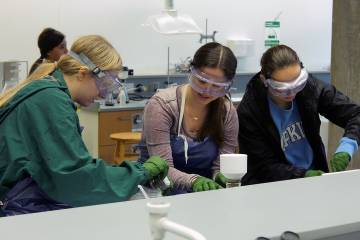Art can be made from any object. Just ask the students in Barbara Gruber's Color Theory Intersession course.
For three weeks this month, they learned the basics of design principles and color theory. For one memorable class meeting, they created art prints with depth and texture using black ink and found objects—a collection of twigs tied together, a discarded bathroom tissue roll, the crumpled petal of a winter flower. Then they were tasked with using a viewfinder frame to spot the design within their etchings.
"I hope students come away thinking that color is serious and fun," says Gruber, an adjunct instructor in Johns Hopkins University's Center for Visual Arts. "[I hope they learn] that chance, revision, randomness, and planning can create incredible design and color combinations. I hope students are excited by color and its possibilities and that they come away from the class looking at color—and at the world—differently."
In addition to their design activity, students also spent the mini-mester learning about observed color, color transparencies, and the relationships and interactions between complementary and analogous colors.
An award-winning painter, Gruber teaches the Painting 1 and 2 workshops at Johns Hopkins each year and has taught Landscape Painting and the Works on Paper course as well. She also teaches at the Maryland Institute College of Art and will teach a 3-credit version of the Color Theory Intersession course at Hopkins this summer.
Posted in Arts+Culture, Student Life
Tagged intersession, center for visual arts








